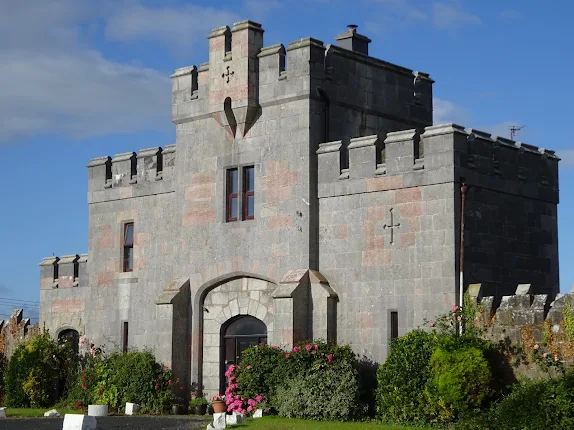For slides view, click on image or text
with King family group on the rear terrace.
The imposing turret was functional, concealing the water cistern that served the house.
Until the age of electric pumps the cistern was filled by a horse-powered pump.
Elm Park
What a pity that no colour-photo study survives of the house before its demolition in the 1960s from which we might appraise the effect of the use of coloured, decorative stone, so successfully applied at the gate lodge.
The 5th Lord Clarina, the white-bearded man in the hat seated in the foreground here with a picnic group at Carrigogunnell Castle, was the last to live at Elm Park.
The era of the coachman and the footman may already be over - see the bicycles in the background, but note that the two gentlemen standing on the right are wearing jodhpurs, and a formally dressed attendant stands ready on the left.
Photograph courtesy of Clare County Library
The editor is much indebted to Mr Mike Fogarty of Orchard View Cottage, Elm Park, for on-site directions, for much fascinating first-hand information on Elm Park, and for making available his impressive collection of documents and period photos of the old Elm Park estate.
Iverus Research Foundation acknowledges the kind permission of the author, Dr Matthew Potter, to reproduce the text of this article.
Editorial Supplement
Cragbeg House
(present house dated to c.1790)
Cragbeg townland, adjoining Elm Park
The NIAH appraisal commends Cragbeg for its 'elegantly composed, simple classical proportions'
which gave its façade 'a sense of restrained grandeur'.
Cragbeg and its acres were leased to succeeding occupants by its non-resident owners, the Barkers,
and late in the 19th century came into the ownership of the 5th Baron Clarina.
The façade is, happily, again fully glazed.
photo: courtesy of Karen Ievers
outbuildings at Cragbeg House:
note the louvred upper floor windows, indicating use as a granary;
the ground floor, with fanlighted doorways,
suggests a domestic use of some style.
Elm Park also had a granary building, in use today as a residence in excellent repair.
Indeed, the 5th Lord Clarina married a Bannatyne of the Limerick milling family;
all indicative of the importance of Limerick as a grain importation and milling centre into modern times.
photo: courtesy of Karen Ievers

.JPG)
%20auto%20corrected.png)
%20auto%20corrected.png)
%20auto%20corrected.png)
%20auto%20corrected.png)


%20auto%20corrected.png)
%20auto%20corrected.png)
%20auto%20corrected.png)
%20auto%20corrected.png)

%20auto%20corrected.jpg)

